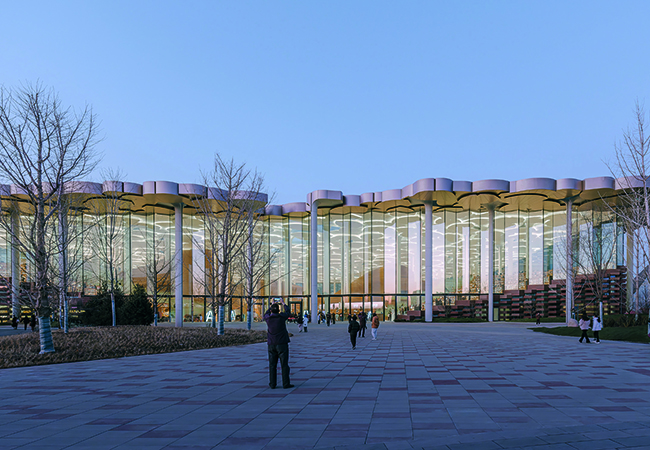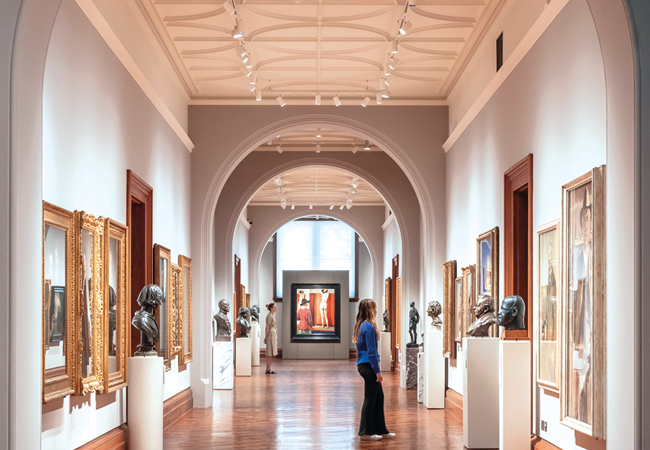
The glass panels on the library are positioned to give the walls a rippling, corrugated appearance
At the centre of Beijing’s new library lies a terraced valley, featuring a winding walkway that connects the north and south entrances. Hill-like mounds of tiered seating, stairs and terraced bookshelves line the route to create a series of informal public spaces for reading, talking and relaxing; the dramatic topography is intended to evoke that of the nearby Tonghui River. Hidden beneath the wooden terraces are private areas for studying, conferences and book restoration.
Tall, slender columns punctuate the internal valley. These burgeon into a canopy-like covering of leaf-shaped panels inspired by China’s native ginkgo trees. The columns support a flat, slender roof that overhangs the 150m x 150m square building. A series of skylights punctuates the roof, flooding the interior with daylight filtered through the ginkgo-leaf canopy.
A 16m-high glazed façade wraps around the giant building to ensure its spectacular interior is on display to passers-by. The glazing is self-supporting, without so much as a steel strut or glazed fin to mar its transparency. The façade’s designers, Eckersley O’Callaghan (EOC), say this is the largest self-supporting glass façade in China and the tallest of its type ever completed.
Project team
Client: Beijing Planning and Natural Resource Bureau
Design architect: Snøhetta
Local partner: ECADI
Façade consultants: Eckersley O’Callaghan
Local façade consultant: Meinhardt
Contractor: CRCEG (China Railway Construction Engineering Group)
It was an achievement recognised by the judges of the Society of Façade Engineering Façade 2024 Design and Engineering Awards, when the scheme won the International New Build category. The judges described it as: ‘A beautiful, sculptural yet highly technical and complex design – superbly detailed.’
EOC’s involvement with the project started in 2018, when it was appointed as façade consultant to the scheme’s architect, Snøhetta, after it won the international design competition with its scheme to ‘reinstate the library’s relevance in the 21st century’.
The firm’s role was to develop the façade concept to ensure it would perform as intended, while rationalising the detailing so the scheme could be built by local teams. ‘We helped steer the design direction and, by liaising with contractors and fabricators, were able to understand the costs and buildability of the various façade proposals,’ says Minxi Bao, associate at EOC.
The architect’s initial concept was based on a glazed façade formed from a series of vertical, 3.2m-wide, curved glass panels – like giant, semi-circular sections of transparent channel stood on their ends. The glass was positioned so that it curved in opposite directions on adjacent panels, to give the walls a rippling, corrugated appearance.
The benefit of this solution, from a structural perspective, was that the curve helped the panels to resist loading, says Bao: ‘We liked the idea, because it gave the façade significant geometrical stiffness, but we understood it would be a challenge to fabricate curved units at this scale.’
EOC went to the world’s leading glass suppliers to find a potential manufacturer for the curved panels. The engineer asked for feedback on the manufacturing feasibility of the panels at two heights: 16m and 20m. This showed that, while it was possible to realise the concept at both heights, the cost of doing so would have been ‘prohibitively expensive’, according to Bao.
Developing an economical solution
EOC set about developing a more economical façade solution that would not compromise the architectural concept. It changed the glazing from curved to a more pragmatic flat panel, which it arranged in a zig-zag fashion. ‘We came up with a pleated solution using flat panels that would be cheaper to manufacture and easier to build,’ explains Bao.
Working with the architect, the engineers also opted for the lower roof height of 16m, to ensure a buildable design that would keep the scheme within cost and buildability constraints.
In-depth structural analysis was carried out on the folded plate proposal to establish the depth and modulation of the plate, the relative stiffness of joints and the required thickness of glass. Specific areas of the façade – such as the building’s corners and its interaction with the portal frames spanning the entrances – also required detailed investigation to ensure the solution’s viability.

To accommodate the vertical movements of the roof, the top connection to the main structure features a slotted hole, allowing the roof to deflect downward by 50mm and upward by 30mm, without loading the glass
The flat, insulating glass units that make up the zig-zag walls are 15.8m high and approximately 2.5m wide. They are assembled from a laminated outer glazed unit comprising five panes of glass bonded together by SentryGlass interlayers. This is backed by a slimmer, two-ply inner unit. The interlayer allows the separate glass plies to act as one. The gas cavity is created by a spacer bar and sealant around the perimeter of the glass panes.
Mechanical connections were investigated for the glass-to-glass connections between adjacent panels, potentially involving cast-in inserts within the glass.
Ultimately, for visual clarity, a simple structural silicone-bonded joint was adopted to attach the vertical edge of one unit to that of its neighbour. ‘The units don’t have any intermediate support along their vertical edges, so all the load needs to be resisted by the glass,’ says Bao.
The panel’s zig-zag arrangement is highly beneficial, enabling the giant glazed panels to work together to efficiently resist wind loading on the façade. Bao explains: ‘If we’d designed a completely flat façade, the glass would have had to be really thick, because we’d end up having to use a significant number of layers [to give it sufficient stiffness]; by adopting a pleated solution, we are able to use the in-plane stiffness of the adjacent glazed units.’
Accommodating roof movements
The glass façade’s design and detailing was engineered to accommodate both vertical and horizontal movements of the main structure, caused by dead loads, wind loads and seismic loads. EOC’s relatively simple solution was to accommodate roof movement in the steel retaining channels at the top and bottom of the glazed units.
Each integrated glazing unit (IGU) has a stainless-steel profile, factory bonded to its top and bottom edges. The profiles slot into steel channels at the top and bottom of the units. These are attached to the building’s structural steel frame. Polytetrafluoroethylene (PTFE) bearings line the sides of the steel profiles to enable the IGUs to slide smoothly up and down, left and right (for the in-plane horizontal) within this channel restraints.
It was not wind loading, but seismic movement that provided EOC with one of its biggest challenges – and, in particular, the interaction of the glass wall with the roof.
‘Beijing is at the junction of three seismic zones, the capital city does have a really high safety factor for earthquake action in the Building Codes,’ says Bao.
Under the worst-case seismic scenario, the building’s sizeable roof, which is held aloft on the grid of slender vertical columns, was predicted to sway by up to 120mm horizontally.

To accommodate this in-plane lateral displacement, steel hemispherical rockers positioned at the centre point of the bottom of a glazed panel allow the IGUs to rock left and right.
Vertical deflections of the main structure are either caused by dead loads, or wind loads. To accommodate the vertical movements of the roof, the top connection features a slotted hole, allowing the roof to deflect downward by 50mm and upward by 30mm, without loading the glass.(see diagram) .
EOC worked closely with the structural engineer in developing the supporting solution to ensure the building’s structure wasn’t over designed and that the architect’s vision was maintained.
To comply with Chinese code requirements, EOC used Finite Element Analysis to model the facade in detail and quantify its performance and capability to accommodate the main structure’s movements.
Allowing daylight in
A regular grid of skylights, set into the giant roof, ensures daylight floods the reading room. From below, the ginkgo leaf-shaped canopy gives these skylights a deceptively irregular appearance.
‘We wanted to make the skylights easy to build, so they are formed from a diagrid frame that is filled with double-glazed units supported on a rectangular hollow frame,’ explains Bao.
If the glazed elements had been any bigger, they would have had to be thicker, adds Bao, which would have increased the weight on the roof, with a corresponding increase in the size of the supporting structure needed. ‘If you remove the ginkgo leaves, the glazed diagrid is quite modularized,’ she says.
The grid of smaller skylights is enhanced by a much larger and irregular-shaped skylight that illuminates the winding central access route along the valley floor. The central skylight is formed from a diagrid of intersecting, hollow section steels, designed to support a regular grid of identically sized double-glazed units.
Controlling solar gains
The architectural requirement for the façade to be self-supporting and free from framing precluded the use of openable vents to allow passive ventilation of the giant reading room.
To keep the interior comfortable in Beijing’s hot summers and cold winters, the glazed panels have a U-value of 1.6W/m2K. Solar gain is controlled primarily by overhanging the roof, shading the façades. In addition, a bespoke high performance low-E coating applied to the glazing gives it a g-value of 0.24, to further limit the amount of heat transmitted through the glass. ‘The glass fabricator customised a specific coating for this project to ensure performance parameters would be met,’ says Bao.
On the east and west elevations, the façade varies in height from 15.8m to 8m, where it rises over a plinth of terracotta blocks, which provide a decorative facade. The 30mm-thick blocks, which are 450mm high and 2,100mm wide, appear to be bonded to the glass, but are actually attached to a subframe hidden behind.
In addition to extensive digital modelling, visual mock-ups of the façade were made to assess the quality of light transmitted to the reading room, which Bao says, ‘is quite subjective’.
The engineers were fortunate that there was no requirement for fire-rated glazing or for fire compartmentation within the glass façade. There was, however, a requirement for 120-minute separation at the glazing interface with the terracotta. This was provided using a steel plate and fire-stop detail.

From an acoustic perspective, the mass of the giant laminated glass units meant the façade’s acoustic requirement of 30dB Rw+Ctr (where Rw is the weighted sound-reduction index in decibels and Ctr is an adjustment factor to account for low-frequency noise) was satisfied for the reading room without additional acoustic treatment.
The façade developed by EOC, also helped to reduce both embodied and operational carbon.
The pleated facade provides the glass with additional stiffness, reducing the amount of material required, which cuts embodied carbon. Furthermore, additional heat energy is required to curve a glass panel, and so, moving from a curved panel arrangement to a flat panel arrangement, meant that the embodied carbon could be further reduced.
With regards to operational carbon, the use of a curved panel would have limited the number of available coatings that could have been applied compared to a standard flat panel. Hence, making use of flat panels meant that the glass could have a better thermal and solar performance, allowing the building to use less energy to heat and cool the library.
The façade also contributed to the building achieving three stars, the highest level, under China’s Green Building Evaluation Label.
The spectacular library opened its doors to the reading public in December 2023, reaffirming the library’s relevance in the 21st century. No wonder the SFE Awards judges were impressed.
Stay Ahead
The Society of Façade Engineering (SFE) brings together professionals to advance knowledge and practice in façade engineering, promoting good practice and ensuring that today’s increasingly complex building façades meet the many and varying performance criteria.
Membership is open to all individuals who have an involvement in façade engineering.
For more information visit www.cibse.org/sfe
Entries for the 2025 façade awards will open soon. Register to be the first to hear: www.cibse.org/whats-on/sfe-facade-2024-design-and-engineering-awards/

